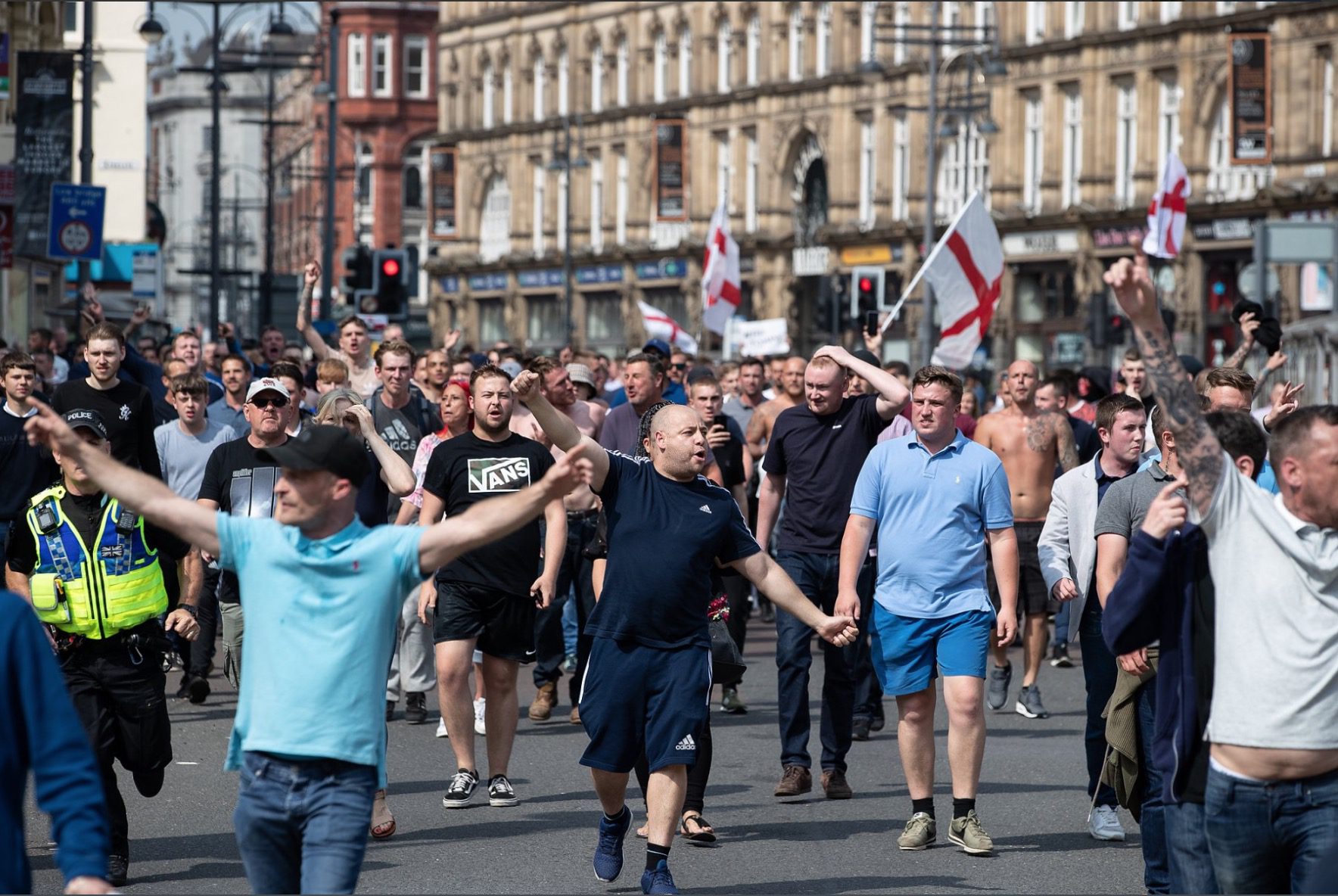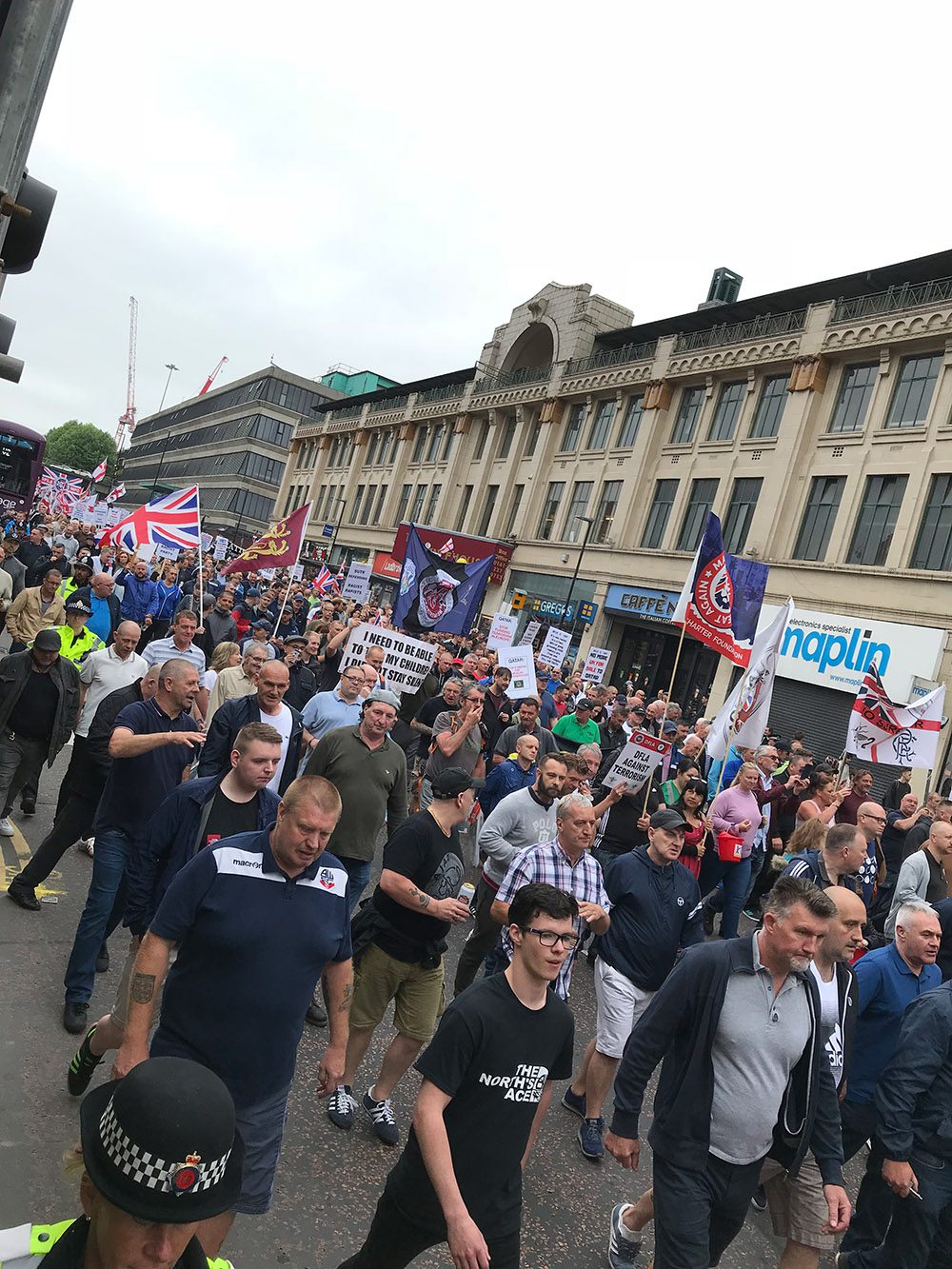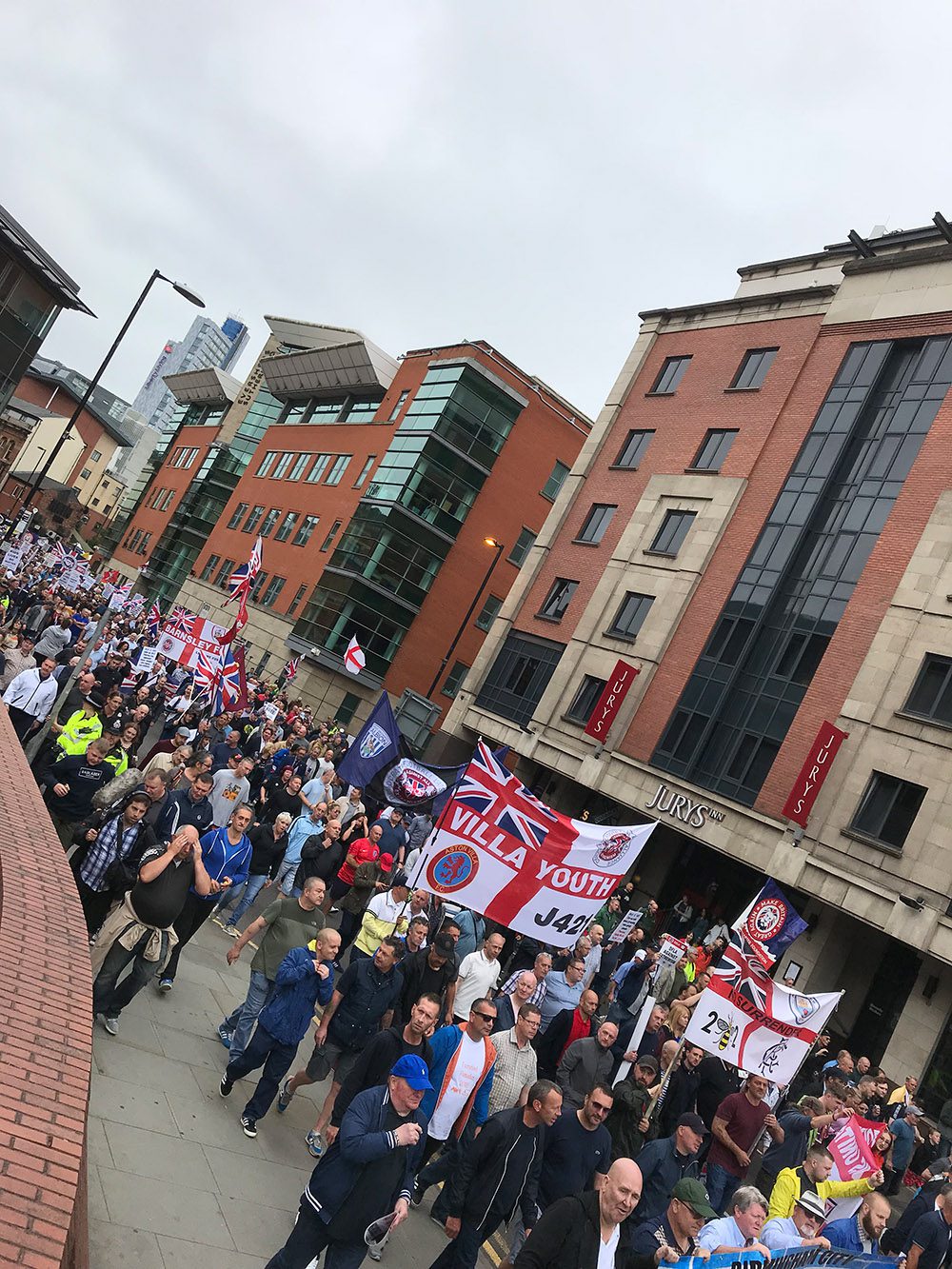This article, by Martin Smith and Tash Shifrin, first appeared on Dream Deferred on 7 June 2018.

A sudden escalation in far right and fascist street mobilisations has taken place in Britain over the space of just seven days.
Snap demonstrations called at 24-hours notice and each turning out several hundred protestors took place in Whitehall, central London on 26 May and in Leeds on 1 June in response to the arrest and then jailing of “Tommy Robinson” – real name Stephen Yaxley-Lennon for contempt of court, an offence to which he pleaded guilty.
These were followed by the planned outing in Manchester of the Democratic Football Lads Alliance (DFLA) on 2 June.
And there is more to come. A “Free Tommy Robinson” demo has been called for 9 June, again in Whitehall, while the UK Freedom Marches umbrella group has called a march in London on 23 June, on the anniversary of the Brexit referendum.
Further snap “Tommy Robinson” demos also seem likely.
The situation in Britain is now similar to many parts of Europe where fascism and the far right have been growing for over a decade.
It is just a month since the “Day for Freedom” event staged by Tommy Robinson outside the gates of Downing Street on 6 May. In our analysis of that event – and the DFLA’s feeder march to it – we argued that it marked a turning point for fascists and the far right in Britain.
It brought together strands from across the far right, from UKIP to the hardcore Generation Identity, which wants an all-white Europe, and the football hooligan firms that make up the DFLA in a strikingly professional and large-scale event. It involved figures, who along with Tommy Robinson himself, have huge social media followings.
The rally was highly ideological and drew on ideas and key individuals from the far right scene across Europe and North America.
New step
But now we have again seen a new step forward for the far right as it shows a capacity for substantial and swift mobilisation on the streets.
The week’s events illustrate the speed with which far right and fascist street movements can grow – and how can develop not in a gradual, linear way but with sudden jumps forward.
For example Hitler’s Nazi Party gained 810,000 votes in 1928 but this rose to a staggering 13,450,000 in 1932. Obviously the situation in Britain now is not comparable to 1932, but the far right is growing at speed.
It seems clear that the success of the “Day for Freedom” has given key activists and followers a huge confidence boost.
We will look in more detail at the “Free Tommy” demos below.
The 2 June march through Manchester by the DFLA, ostensibly to mark the anniversary of the Manchester Arena attacks, had been aimed mainly at solidifying the DFLA’s position in the battle for control of the Football Lads Alliance (FLA). For details of the ructions in the far right football hooligans’ organisation, see our analysis of the factional battle here.

And following the FLA’s own demo in Manchester on 19 March, which flopped, the DFLA seems to have won.
Yet its long-planned event was swept up in the Free Tommy fever too.
The DFLA turned out around 2,000 in Manchester, overwhelmingly from the north of England and West Midlands. This was a strategic move, aimed at developing its organisation in different parts of the country.
So it has now organised large demonstrations on London, Birmingham and Manchester. Through these regional protests they are creating a national network and organisation built around football firms. Movements like this have rejuvenated the far right in Poland, Hungary and to a lesser extent Germany.
The FLA was formed primarily from the big London football hooligan firms associated with Tottenham, West Ham, Arsenal and Millwall in particular.
Two London marches were followed by rival FLA and DFLA mobilisations in Birmingham, which leaned heavily on the West Midlands firms.
The 2 June demo showed very little travelling presence from London, although Millwall was represented with a large banner and two speakers at the final rally.
We saw marchers from football firms associated with Newcastle, Stoke City, Aston Villa, Birmingham City, Manchester City and Manchester United, Rangers, West Brom, Barnsley and Bolton.

Its organisation drew on remnants of the English Defence League, with former EDL regional officer Antony Bamford among the admins on a secret DFLA northern division Facebook page.
Yorkshire EDL regional officer Scott Walker was also involved in the northern division group, while Leon McCleery – the Loyalist who was a member of the EDL’s national leadership group – was filmed the demo.
The fast-growing new far right movement has coalesced from a wide range of far right and fascist groups and individuals, with shifting alliances and a continual tension as different groups jockey for influence.
For this reason the DFLA has sought to retain its own identity, organising its own feeder march into the Day for Freedom event. Its leaders had called for a “silent march” supposedly to honour the victims of the Arena attacks.
But before it started, different firms gathered in the pubs of central Manchester and marched into the assembly point singing Tommy Robinson’s name.
And for a silent march, there was pretty continuous chanting for Robinson throughout.
There were fewer political flags on display than on the feeder march in May, although the People’s Charter / Make Britain Great Again group had a banner and there was a “Don’t tread on me” snake flag, featuring a favourite motif of the US “alt-right”.
A group of DFLA supporters diverted before the march to threaten and abuse counter-protestors from Stand Up to Racism and as the march moved up Oxford Road, demonstrators interrupted their “Oh Tommy Tommy” chant to sing “You’re not English any more” and “Muslim peados off our streets” at local bystanders who objected to the march.
Despite the wishes of the DFLA leaders to emphasise that their demo was not a Free Tommy event, its members thought otherwise and chanting for Tommy Robinson was general throughout the march.
This is unsurprising: the fascist poster boy is a hero to them too, with the DFLA’s audience and Tommy Robinson’s largely overlapping.
The week’s three mobilisations put on the streets thousands of people, many of whom follow several different groups at once on social media – with Islamophobia the key mobilising factor. There are interconnecting networks of fascist and far right racist activists who are ready to turn out for anything that looks “lively”.
Unexpected
That became clear on Saturday 26 May, the day after the Robinson arrest, when several hundred gathered in Whitehall outside Downing Street in an unexpected protest that caught the police on the hop.
While many antifascists were cheered by Robinson’s jailing, it’s a mistake to see this as any kind of setback either for the man himself or his movement.
It will instead increase his anti-establishment credentials. He is using his jailing to extend his political influence both here and abroad.
And the impressive nature of the Day for Freedom event, called at Downing Street – one of the symbols of parliamentary democracy – has given the far right the confidence to head straight there in protest.
This was the first time fascists had held such a rally in Whitehall – its success means they are going back. It would be a serious setback for antiracists if the fascists can normalise their right to protest in Whitehall.
It is also a very different scenario to the days of the English Defence League, when provincial towns were seen as the main “home territory” for its demos.
Network
The 26 May snap Whitehall demo appears to have been called by two individuals who in turn are plugged into several parts of the far right network, Vinnie Sullivan and pal Danny “Tommo” Thomas.
Sullivan has his own podcast under the banner of “The Reality Report”, along with a linked line of merchandise.
But he is a supporter of Generation Identity and attended the grouplet’s tiny conference in Sevenoaks in April this year. GI has only a handful of members in Britain but has a larger presence in several European countries.
It is a hardcore cadre organisation that often seeks to work within larger far right or fascist parties and has a significant ideological influence internationally.
Sullivan spoke at the rump FLA demo in Manchester in May, a small and downbeat event.
But his initiative at Whitehall took off – a sign of how individuals connected with tiny hardcore fascist groups can influence much wider layers of the far right movement.
He and Thomas were also the initators of the Free Tommy protest set for 9 June, again in Whitehall, which is now being promoted heavily on the official Tommy Robinson facebook page.
On the afternoon of Friday 1 June, a similar snap protest took place outside Leeds crown court, with demonstrators taking control of the streets in an impromptu march afterwards.
That event seems to have been initiated by Luke Gudge, who has connections with a range of fascist and far right individuals including Sullivan and his GI pals, through a hurriedly set up Facebook page called Proud British.
Just days after the Leeds demo, there were arson attacks on a mosque and a gurdwara (Sikh temple) in the city. The pattern of racist and fascist marches being followed by individual racist attacks is a very longstanding one.
The Free Tommy demo called for 9 June looks set to be a very substantial size. There is a motivated, do it yourself feel to the linked series of facebook pages organising car shares and other joint transport arrangements.
Former Breitbart chief Raheem Kassam, a key far right figure in Britain with personal links to US president Donald Trump, has floated the idea of nationally organised coaches.
International
And the movement in Britain is also being encouraged by support from far right figures internationally – Tommy Robinson is the posterboy for fascists and racists internationally.
He is an icon for anti-Muslim racists and his prison martyrdom makes him an ideal “anti-establishment” figurehead, supported by an alternative far right media depicting him as a hero of free speech, battling the forces of the state.
UKIP’s leader Gerard Batten has spoken out for Tommy Robinson and now seems bent on rebuilding his party on the back of the new far right street movement – a clear break from Nigel Farage’s careful distancing from outright fascists and street thugs.
Batten is doing this because UKIP can no longer make political headway over Europe and Batten thinks he can revive UKIP by piggy backing on the developing street movements in Britain. This is what the AfD managed to do in Germany.
Geert Wilders, leader of the far right racist populist PVV party in the Netherlands, is due to speak at the 9 June demo, while international support has come in from Donald Trump Junior, the US president’s son, prominent politicians from Germany’s far right AfD, notoriously racist Australian senator Pauline Hanson and others.
There have been small Free Tommy pickets and protests in several countries.
But 9 June in Whitehall will not be small. We are seeing a speed-up in the development of the new far right in Britain.





